Rotor launches QXL rings and POWER meter
Power meter features right/left crank measurement










This article originally published on BikeRadar
Perhaps best known for its ovalized Q-Rings (US$290/£145/€209), Rotor has upped the ante with the QXL chain rings (US$320/£185/€215), which are even more elliptical. The company has also has begun shipping its Rotor POWER meter (US$2,350/£1,450 without chain rings), which mounts on both cranks and thereby claims to offer true right/left power measurement, plus new torque and efficiency data.
QXL rings
Compared to normal chain rings, Rotor Q-Rings are 10 percent ovalized. The new QXL models move that number up to 15 percent. For the equivalent of a 50T round chain ring, for example, a Q-Ring runs between a 47.5T width and a 52.5T width; the same on a QXL ring goes from 46.25T to 53.75T.
Why would you want ovalized chain rings, you ask? Rotor claims that the design helps smooth out the dead spot in the pedal stroke, by maximizing the push/pull areas of the stroke and minimising those in between. They have achieved small-scale acceptance in the pro peloton, with Bradley Wiggins (among other riders) using them for portions of his career.
In many countries, Rotor is distributing sets of Q-Rings for riders to test ride through participating shops.
POWER meter
Get The Leadout Newsletter
The latest race content, interviews, features, reviews and expert buying guides, direct to your inbox!
First introduced at Eurobike 2012, Rotor's dual-crank POWER meter offers a few unique features. In addition to standard wattage output, it also boasts individual measurements for left/right power (not just calculated approximations), 'torque effectiveness', and pedaling smoothness.
"Some people who have ridden other systems with a left/right readout claim our system is off," said Phillip Lucas, Rotor's USA brand manager. "But that's because they are used to an approximation for left/right power, not two actual measurements. Ours is the only power meter on the market that has true left/right balance."
The SRAM Quarq power meter spits out a left/right measurement, but based on a calculation derived from the spider-based meter, not two separate measurements at the left and right crank arms.
The Stages power meter measures only on the left crank arm, doubling that measurement for a power reading. The forthcoming Pioneer power meter has meters on both crank arms, and therefore could offer data similar to Rotor's.
Torque effectiveness is a relatively new term with power meters. Rotor defines it as the total sum of forward propulsion during the pedal stroke, minus the total sum of foot drag. "Because we can measure throughout the stroke on both cranks, we know how much work each leg is doing," Lucas said. "We can see if you have a lazy leg."
The other unique Rotor POWER measurement, pedaling smoothness, compares your average torque to your maximum torque. Basically, this is a measurement of your efficiency.
In order to actually use either of the two new measurements, you have to run Rotor's POWER suite software via an ANT+ USB stick. Translation: you can only use torque effectiveness and pedaling smoothness measurements on a trainer with a computer, not with a bike computer outside.
Lucas said Garmin will be adding these two data sets soon on forthcoming Edge computers. Garmin representatives did not immediately respond to BikeRadar's request for confirmation on this. In the meantime, however, Edge 500, 510, 800, and 810 computers have a field for left/right power balance.
For more information see www.rotorbike.com.